Because to its many advantages, lactic acid is a common component in skincare products. The body naturally produces this alpha hydroxy acid, which can be used to exfoliate skin, remove dead skin cells, and treat acne. It can also make skin look better by minimizing wrinkles and fine lines and giving it a more youthful appearance. What if you have delicate skin, though? How can you choose the lactic acid product that would perform best for your sensitive skin if you’re seeking for one? Try [product name], which has been carefully developed to include a high concentration of lactic acid without irritating delicate skin.
We’ll discuss what lactic acid is, how it functions, some possible adverse effects, and more in this post. We’ll also discuss why those with sensitive skin, in particular, might not benefit from using lactic acid, as well as how to choose the finest lactic acid product for your individual requirements.
Read on to learn more about How To Use Lactic Acid For Sensitive Skin, Most-Asked Questions About Dark Knucklesand How Does Using Lactic Acid Benefit Your Skin?
:max_bytes(150000):strip_icc():gifv():format(webp)/010821_oils_lead-2000-e3252621eece466baed164dc0930fe95.jpg)
How To Use Lactic Acid For Sensitive Skin
Using expired sour milk on your face probably seems like a recipe made in TikTok hell, but lactic acid is actually a chemical exfoliant that’s gentle enough to treat acne and uneven texture on sensitive skin.
Luckily, there’s no need to play around with the spoiled jug of milk that’s been in the back of your fridge for months. Beauty brands have long been onto the benefits of lactic acid, safely incorporating it into their serums, creams, and masks.
But before you add any lactic acid products to your cart, we turned to a top dermatologist and chemist to get a full breakdown on what the chemical exfoliant does for your skin and the best methods for incorporating it into your routine.
What to Know About Chemical Exfoliants Before Applying Them to Your Skin
How Does Using Lactic Acid Benefit Your Skin?
Lactic acid is an exfoliating alpha hydroxy acid (AHA) that is found naturally in milk, but it can also be produced synthetically in a lab.
“Acids can remove several layers of dead skin in just one treatment allowing treatment products and skincare to effectively penetrate the skin,” says Dr. Michele Green, a board-certified cosmetic dermatologist in New York City. “They can remove blemishes, fade sunspots, improve skin tone, texture, reduce hyperpigmentation and superficial wrinkles.”
In the case of lactic acid, it can be used as both an anti-aging and acne treatment because it exfoliates, improves fine lines and wrinkles, and improves the appearance of discoloration.
Michelle Wong, cosmetic chemist and founder of Lab Muffin points out that while lactic acid is an exfoliant, it’s also a hydrating humectant. “It can hydrate your skin, reduce clogged pores, smooth out skin texture and help fade pigment,” she says.
Who Should Use Lactic Acid?
For sensitive skin types, lactic acid can be a great chemical exfoliant because it’s gentler than other AHA and BHA acid.
“Lactic acid is best used on sensitive skin because it is a mild exfoliant which will not disrupt the pH of the skin or cause redness and irritation,” Dr. Green says.
Because lactic acid has a larger molecule size in comparison to other AHA acids, it doesn’t penetrate the skin as deeply, providing a more superficial exfoliation. In other words, lactic acid isn’t as potent, but it can still be effective, which is ideal for sensitive skin types that are prone to irritation.
8 Exfoliating Toners to Turn to For the Glowiest Skin of Your Life
What Ingredients Don’t Play Nice With Lactic Acid?
“Lactic acid should not be used in conjunction with other forms of AHA’s or in addition to using BHA’s, retinols or tretinoin,” Dr. Green shares. “These ingredients all cause cell turnover and some degree of exfoliation. When combined together, they can cause severe skin irritation.”
Wong says that because lactic acid products are at a low pH, they can conflict with pH-sensitive ingredients such as peptides. “Usually it’s not a big problem if you wait 15 minutes between applying products,” she says.
How Should You Use Lactic Acid in Your Skincare Routine
There are a number of products infused with lactic acid, from cleansers to serums to face masks. While which one you try is up to you, it’s always best to consult with a dermatologist if you’re unsure about adding anything new to your existing routine.
Just don’t forget to apply SPF every morning, because like other exfoliants, lactic acid can cause sun sensitivity.
“Lactic acid is also a melanin suppressor therefore it inhibits tyrosinase which is the enzyme responsible for melanin production,” Dr. Green says. “Because it decreases your melanin production, you should wear sunscreen and protective clothing to protect the treated areas from sun damage.”
Due to this reduction in melanin production, Dr. Green says the skin is “noticeably healthier, lighter, and brighter almost immediately.”
VIDEO: When You Apply Sunscreen in Your Skincare Routine Actually Matters A Lot

Kendall Jenner and Devin Booker Have Reportedly Broken Up
The 5 Best Lactic Acid Products
Philosophy Renewed Hope in A Jar Facial Moisturizer
:max_bytes(150000):strip_icc():format(webp)/011521-lactic-acid-embed4-443a66bc91ea4f6ea7fd3d1467d1876f.jpg)
Dr. Green is a fan of Philosophy’s classic moisturizer because it’s lightweight and filled with lactic acid and antioxidants. Bonus: the updated formula now contains SPF 30 protection to help streamline your routine.
To shop: $39; sephora.com
Sunday Riley Good Genes All-In-One Lactic Acid Treatment
:max_bytes(150000):strip_icc():format(webp)/011521-lactic-acid-embed2-7d2f0a5b00884ca49da85ebe86b68491.jpg)
Along with the rest of the internet, Dr. Green sings the praises of Sunday Riley’s cult-favorite lactic acid-powered serum. “This product is great, containing both lactic acid and licorice, which work great for anti-aging and hyperpigmentation.”
To shop: $85; sephora.com
Dermalogica Skin Resurfacing Lactic Acid Cleanser
:max_bytes(150000):strip_icc():format(webp)/011521-lactic-acid-embed3-9526585b6bd34ecda98b334a4aeebbaf.jpg)
This cleanser gently exfoliates skin while simultaneously nourishing it, thanks to a blend of vitamin E and rose flower oil.
To shop: $45; sephora.com
SkinCeuticals Clarifying Clay Mask
:max_bytes(150000):strip_icc():format(webp)/011521-lactic-acid-embed1-f5ac69b5bfec4418864d3216d38fcd40.jpg)
While clay masks are great at sucking excess oil from your pores, they also notoriously drying. That’s why in addition to adding a 2% exfoliating acid blend to its mask, SkinCeuticals has also included a mix of soothing ingredients such aloe and chamomile to keep skin soft and supple.
To shop: $55; dermstore.com
The Ordinary Lactic Acid 10% + HA
:max_bytes(150000):strip_icc():format(webp)/011521-lactic-acid-embed5-0dcf8cd97d0d421baeafdd72cd13fe91.jpg)
For anyone looking to experience lactic acid for the first time without spending too much coin, The Ordinary’s serum is your best bet. In addition to 10% lactic acid, it contains smoothing hyaluronic acid to give skin a hydrated, plump look and Tasmanian pepperberry to offset potential irritation.
Dark knuckles cream recipe
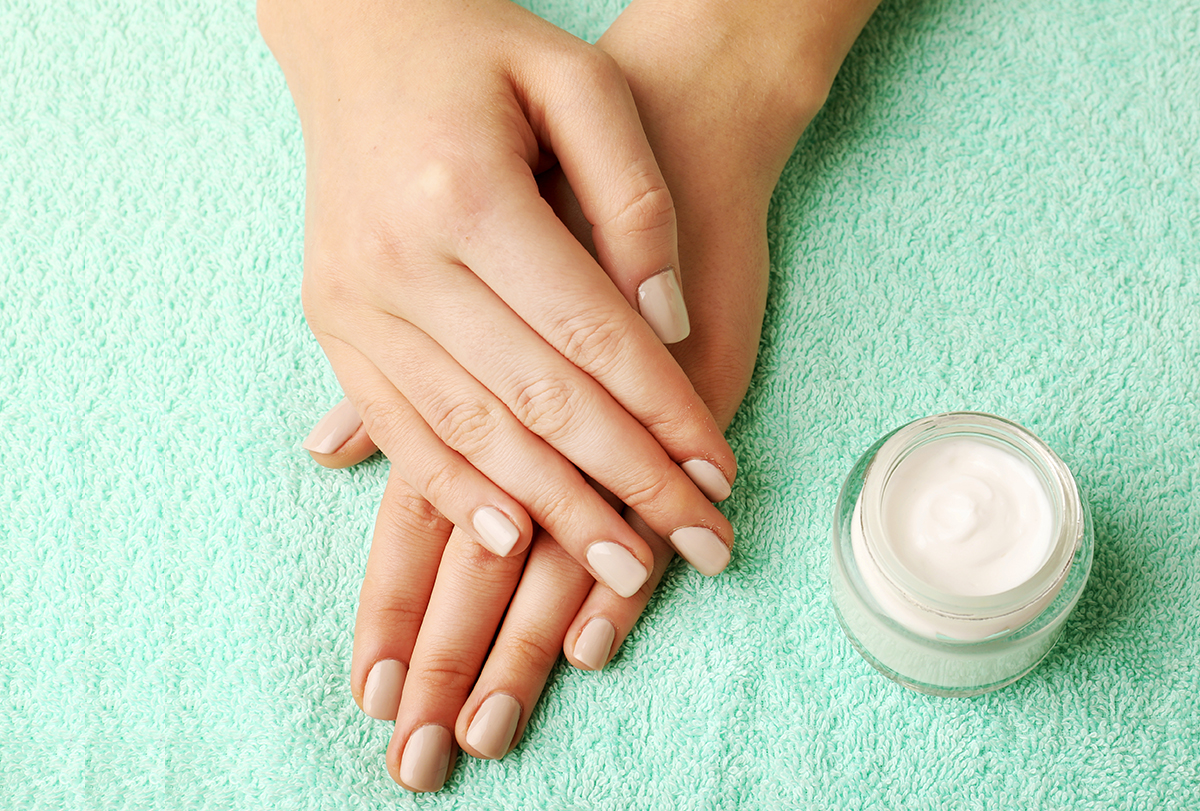
It is, therefore, very important that you give your hands the necessary care to undo this damage and keep them in the best shape.
One of the most common hand-related complaints is knuckle hyperpigmentation or darkened knuckles, which can develop at any age. This occurs due to an increase in melanin synthesis in the skin covering your knuckles. Skin color is determined by the amount of melanin pigment in the skin – the more melanin, the darker the skin.
This article takes you through the different treatment options and self-care measures to lighten dark knuckles.
Advertisements
Causes of Dark Knuckles
A number of factors can contribute to the overproduction of melanin in the knuckles, including:
- Hormonal changes or hormone-related disorders such as polycystic ovary syndrome (PCOS)
- Poor hygiene
- Use of cosmetics and/or fragrance-based chemical products
- Work or sports that cause excessive friction on the knuckles such as boxing
- Eczema
- Psoriasis
- Acanthosis nigricans
- Diabetes
- Dermatomyositis
- Addison’s disease or other autoimmune disorders
- Vitamin B12 deficiency (1)(2)
- Drug reaction
- Malignancy
- Genetics
Treatment for Knuckle Hyperpigmentation

The first-line treatment for knuckle hyperpigmentation depends on the underlying condition and includes:
- Prescription medications, including topical vitamin D compounds, keratolytics such as topical retinoids (tretinoin 0.05%), and oral melatonin
- OTC topical products, including zinc sulfate, salicylic acid ointments, glycolic acid creams, arbutin, azelaic acid, and kojic acid, which may be used as monotherapy for milder cases (3)
If these primary interventions fail to deliver the desired results, your doctor may recommend the following clinical procedures as second-line treatment to fade the hyperpigmentation:
- In-office skin peeling using chemical agents such as glycolic acid 20%–70%, salicylic acid 20%–30%, trichloroacetic acid (TCA) 10%–25%, and Jessner’s solution, along with some topicals (4)
- Laser treatment with low-fluence Q-switched Nd:YAG, Er:YAG, or CO2 laser, to be immediately followed by daily application of a broad-spectrum sunscreen
- Microdermabrasion to exfoliate the dark, damaged skin so that it can be replaced by new, brighter layers from underneath
- Cosmetic camouflage
Home Remedies to Lighten Mild Knuckle Hyperpigmentation
The following home remedies may help in improving dark knuckles.
1. Milk, milk cream, and yogurt
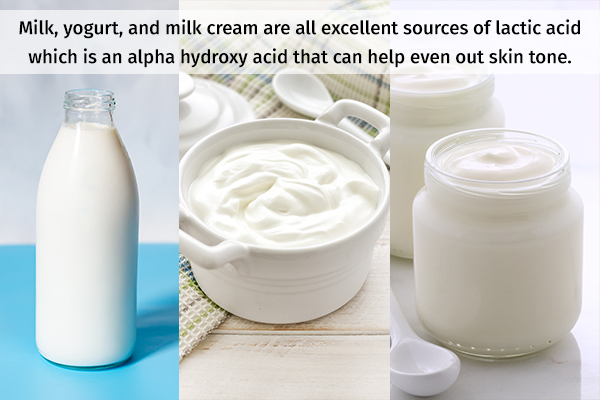
Milk, milk cream, and yogurt (5) are all excellent sources of lactic acid, which is an alpha hydroxy acid that can help even out skin tone. In fact, alpha hydroxy acids are routinely used in in-office chemical peeling procedures to treat hyperpigmentation. (6)(7)
How to use:
- Take the same amount of yogurt and rose water in a bowl, and add in 1 teaspoon of vegetable glycerin.
- Mix all the ingredients well to make a paste. The consistency of the mixture should be thick enough for it to stick to the skin. If it’s too runny, add a little bit of sandalwood, gram flour, or oatmeal powder to give it volume.
- Before going to bed, rub this paste all over your hands or just your knuckles until it seeps completely into the skin.
- Wash your hands with cool water the next morning.
2. Pomegranate juice
Pomegranate juice can also be used to lighten hyperpigmented knuckles. (8)(9) It also exerts an antioxidant effect due to its phenolic content. (10)
Advertisements
How to use:
- Apply pomegranate juice to your darkened skin.
- Let it dry before rinsing it off.
3. Honey and milk
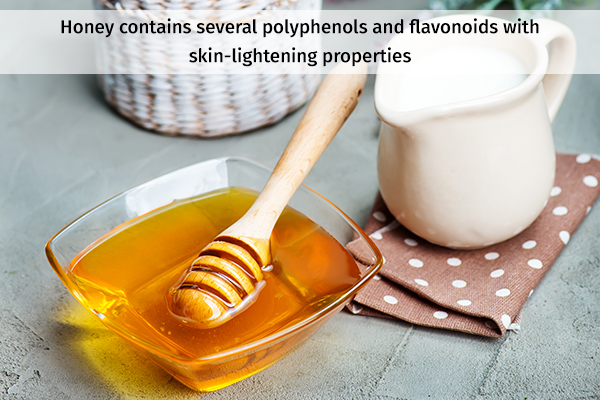
Honey contains several polyphenols and flavonoids with skin-lightening properties. (11) Plus, it is deeply hydrating, promotes faster skin healing, and protects against further skin damage.
How to use:
- Take half of a ripe avocado in a bowl, and mash it with a fork to make a thick, lump-free paste.
- Pour in 2 teaspoons of raw, organic honey and 1 teaspoon of milk, and give the mixture a final stir so that all the ingredients are well blended. You can also use medical-grade honey if you can’t get your hands on the organic varieties.
- Smear the paste all over the knuckles.
- Let it dry on its own and then wash it off with lukewarm water.
4. Turmeric, gram flour, and milk cream
Turmeric can also help lighten darkened knuckles (12)(13) and heal sunburnt skin. (14)
How to use:
- Put 2 teaspoons of milk cream, 2 tablespoons of gram flour, and a pinch of turmeric powder in a bowl, and mix all the ingredients well to make a smooth paste.
- Apply this mixture to your hands or just your knuckles.
- Let the paste dry for 15 minutes and then wash it off with lukewarm water.
5. Aloe vera gel
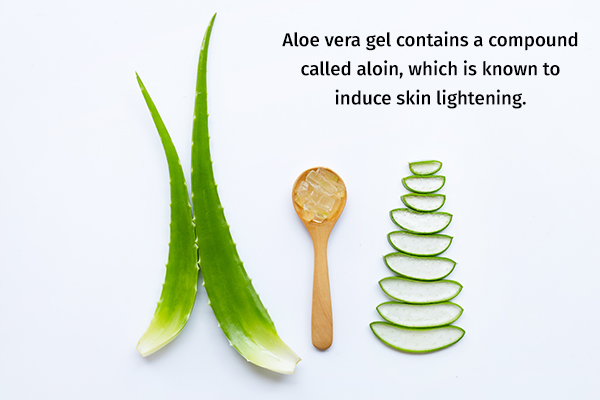
Aloe vera gel contains a compound called aloin, which is known to induce skin lightening. (15)
How to use:
- Extract the gel from a freshly cut aloe leaf. Optionally, add in 1 teaspoon of lemon juice to 2 tablespoons of aloe gel for better results, as lemon juice also exerts bleaching effects.
- Apply the aloe gel to the darkened knuckles.
- Leave it on for 20 minutes before rinsing it off.
6. Paraffin wax
Paraffin wax moisturizes and softens the skin. It also strengthens the skin barrier, aiding in the prevention of water loss and therefore skin dryness. In addition, paraffin wax transfers heat to the skin, helping open and clean the pores, giving your skin a lighter complexion.
How to use:
- Melt some paraffin wax. Make sure the wax is not too hot.
- Dip oiled hands in it for a few seconds and then take them out.
- Allow the wax to dry and form a thin layer, and then dip your hands in the wax again, repeating the procedure 5–6 times.
- Cover your hands for 15–20 minutes and then wipe off the wax.
7. Skin-lightening oils

Certain healing oils exhibit bleaching effects that can help lighten hyperpigmented knuckles. These include rosehip oil, (16) almond oil, mulberry extract oil, (17) vitamin C oil, (18) and sandalwood oil. (19)
How to use:
- You can either massage your skin with these oils daily or add them to your DIY skin-lightening masks.
- You can also make your own skin-lightening oil by mixing almond oil and orange peel powder, lemon extract, and/or turmeric.
Note: When using sandalwood oil, make sure to dilute it with a carrier oil before application as it can be too harsh or corrosive for your skin when applied directly.
Advertisements
8. DIY scrubs
You can prepare your own homemade scrub with all-natural ingredients that can gently remove the dead skin on your knuckles without causing any irritation.
How to use:
- Mix exfoliating particles, such as slightly ground uncooked lentils, walnuts, salt, or sugar crystals, in a base of coffee, unsweetened yogurt, rose water, vitamin C serum, (20) or honey. Avoid adding anything acidic, such as lemon juice or apple cider vinegar, to the scrub.
- Massage the paste over your knuckles for a few minutes, using light circular motions.
- Leave it on for a few more minutes before washing it off with lukewarm water.
9. Shea butter and coconut milk cream
Your hands become dry easily as they get frequently washed and are exposed to a lot of irritants daily. Dryness can make your skin wrinkly, dull, and dark, which calls for regular moisturization of your hands.
You can prepare your own hand cream by using deeply hydrating ingredients such as shea butter and coconut milk cream.
How to use:
- Mix shea butter and coconut milk cream.
- Moisturize your hands using this cream.
- Repeat the application throughout the day as needed.
Skin-Lightening Moisturizers, Creams, and Serums
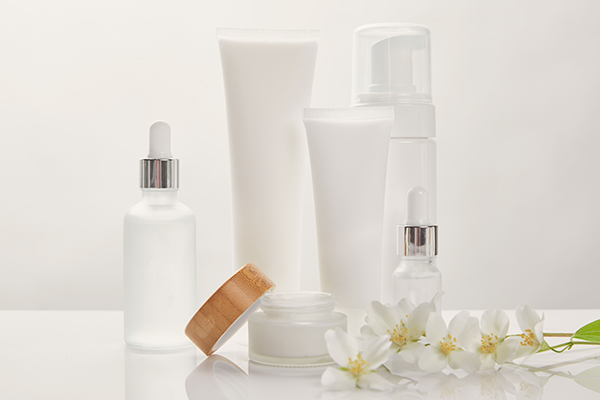
Some skin-lightening products, such as medicated ointments, barrier creams, keratolytic-infused moisturizers, serums, and gels, must be prescribed by a dermatologist only. However, not all will yield results.
It is important to know what ingredients in these products can actually help in reducing hyperpigmentation. Here’s what you should look for: (21)(22)(23)
- Lipohydroxy acid
- Soy
- Niacinamide
- Ceramide
- Aloin (24)
- Strawberry extract
- Aloesin
- Gentisic acid
- Hesperidin
- Grapefruit seed extract
- Licorice extract (25)
- Pomegranate extract
- Kojic acid
- Salicylic acid
- Glutathione
- Deoxyarbutin
- Vitamin C
- Quercetin
- Rose extract
- Cinnamic acid
- Green and white tea extract (26)
- Mulberry and coffee berry extract
Self-Care Measures

The following self-care measures can accelerate lightening of your knuckles:
Advertisements
- Knuckle hyperpigmentation is a common symptom of vitamin B12 deficiency. (1) Vitamin B12 plays an important role in collagen synthesis and generation of new skin cells. You can increase your vitamin B12 intake through foods such as meat, poultry, fish, and dairy. You can also consume vitamin B12 supplements or vitamin B12-fortified foods for the same.
- A fairly common endocrine disorder called polycystic ovary syndrome (PCOS) can also cause knuckle hyperpigmentation. (27) Although there is no cure for PCOS, it can still be managed through proper medical treatment, which aims at correcting the hormonal imbalance underlying this condition. Plus, several lifestyle changes such as reducing weight, proper diabetes management, healthy eating with a good dose of vitamins A and C, and stress control may also help reduce the severity of the symptoms and enhance the efficacy of the prescribed treatment.
When to See a Doctor
Dark knuckles are rarely a cause for concern, but they can sometimes stem from health issues that need medical evaluation and treatment.
So, it’s best to get yourself checked by a doctor if the hyperpigmentation occurs all of a sudden or continues to darken even after the necessary skin care and preliminary treatment.
Plus, you must seek medical help if you experience any of the following symptoms, which can point to a more grievous cause:
Advertisements
- Fatigue
- Itching
- Dizziness
- Pain
- Inflammation
- Oozing
Most-Asked Questions About Dark Knuckles
Can I bleach my darkened knuckles?
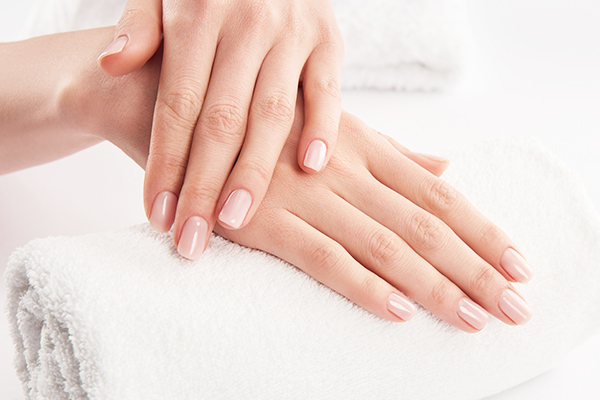
No. Bleaching with OTC creams such as 1% hydroquinone creams or bleaching powder solutions can cause burns or can damage your skin in other ways. Hydroquinone is banned in some countries; therefore, use it only if your doctor suggests it.
Can I use lemon juice to treat my knuckle hyperpigmentation?
Lemon or lime juice is replete with vitamin C, which is known to exhibit antityrosinase activity, which inhibits melanin formation. (30)
But because lemon juice is highly acidic, it can be caustic on your skin and can even disrupt its natural pH balance. Plus, topical use of lemon juice can render your skin more susceptible to solar damage, which will inadvertently worsen your hyperpigmentation.
For these reasons, skin experts generally advise against using this remedy topically for skin concerns such as dark knuckles.
Can orange peels help lighten my darkened knuckles?
No. Even though research suggests that orange peels (Chinese orange variety) are potent tyrosinase inhibitors, (31) only their alcoholic extracts are credited with this property and not the peel itself. Therefore, direct application of orange peels will most likely have no effect in reducing the hyperpigmentation of your knuckles.
Final Word
Not all cases of darkened knuckles warrant medical intervention, especially when there is no underlying illness at play. Even simple factors such as negligent hand hygiene, excessive exposure to sunlight and harsh detergents, or too much friction against the knuckles can make the affected skin darker.
In such cases, taking better care of your hands should be enough to bring your darkened knuckles back to their true color. This includes proper handwashing, regular moisturizing to keep the skin soft and hydrated, wearing gloves when handling chemical irritants, and applying sunscreen to block out solar radiation.
If your condition fails to improve, becomes worse, or is accompanied by new worrisome symptoms despite all these self-care efforts, you must seek medical consultation to identify the root of the problem and get appropriate treatment accordingly.
Dark knuckles causes

Dark pigmentations of the knuckles can be as a result of various factors. It may be the reaction to a certain intake of drugs, It may also be inherited and could be a sign of vitamins the body is lacking.
Nevertheless, the factor associated most with black knuckles is as a result of the strong acidic substance found in products used on the skin, breaking down the melanin present in it. These products are commonly referred to as bleaching creams.

Drug reactions
Other than bleaching creams usage of these drugs is linked to why the knuckles could get darker than other parts of the fingers.
These drugs are:
- Nicotine acid
- Estrogen therapy
- Growth hormone therapy
- Protease inhibitors
Drug containing these substances causes the knuckles to have darker pigmentation.
Lack of Vitamin B-12
Vitamin B-12 is a water-soluble vitamin that helps to create red blood cells. The red blood cells help to carry oxygen through the body. When the body does not have enough Vitamin B-12, it could cause the knuckles to start losing its color and get darker.
The symptoms of lack of vitamin B-12 include:
- Shortness of breath
- Dizziness
- Fatigue
- Headache
The body system extracts this vitamin from foods such as egg, milk, cheese, and meat. When the body gets little of these foods the skin starts to lose its glow and the knuckles amidst other areas of the body that has higher pigmentations get darker.
Skin lightening products
Many skin lightening products contain Hydroquinone or Lipohydroxy acid which is derived from salicylic acid. These acids bleach the skin by breaking down the number of melanocytes which produces melanin that helps to give the skin a brown color. These compounds are artificial and are recommended mostly to be used for treating skin issues like; melasma, acne scars, eczema and dark spots.
When products containing these acids are used other than for skin treatment, the skin reacts to it especially parts of the skin that have hyperpigmentations. The knuckles are part of the body parts that have hyperpigmentations, so it proves really hard for bleaching products to penetrate and lighten them.
There are more natural ingredients and simpler ways to get rid of dark knuckles, they are as follows:
Soy
The varieties of soy can help lighten the knuckles, It could be either in the bean or milk form. for use, it is recommended to apply on the surface of the knuckles and rinse out after a couple of minutes or leave in longer as desired. The nutrients in soy suppress skin pigmentations from surfacing.
Ellagic Acid
This is extracted from fruits like cherries, pomegranates, and strawberries. Often intake of these fruits and making scrub mixtures with it brightens the knuckles. The acid stops one of the enzymes that helps in the secretion of melanin in the skin.
Sugar and olive oil
Sugar and olive oil mixed together as a scrub helps to exfoliate the dead skin cells on the knuckles. Sugar removes the dead skin cells on the surface of the knuckles while olive oil moisturizes the skin, giving it the glow you desire.